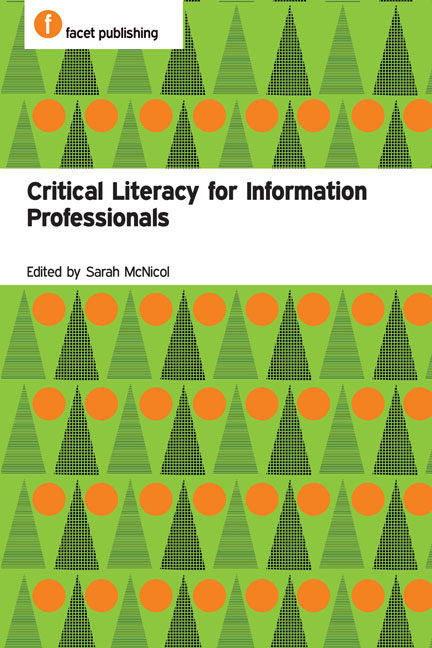Book contents
- Frontmatter
- Contents
- Contributors
- Introduction
- PART 1 THEORIES OF CRITICAL LITERACY
- 1 Renegotiating the place of fiction in libraries through critical literacy
- 2 Death of the author(ity): repositioning students as constructors of meaning in information literacy instruction
- 3 Reading health-education comics critically: challenging power relationships
- 4 Reframing librarians’ approaches to international students’ information literacy through the lens of New Literacy Studies
- 5 Using new literacies to discuss disability in the library
- 6 ‘Anyone can cook’: critical literacy in the workplace
- 7 Social justice, adult learning and critical literacy
- PART 2 CRITICAL LITERACY IN PRACTICE
- Further information
- Index
3 - Reading health-education comics critically: challenging power relationships
from PART 1 - THEORIES OF CRITICAL LITERACY
Published online by Cambridge University Press: 08 June 2018
- Frontmatter
- Contents
- Contributors
- Introduction
- PART 1 THEORIES OF CRITICAL LITERACY
- 1 Renegotiating the place of fiction in libraries through critical literacy
- 2 Death of the author(ity): repositioning students as constructors of meaning in information literacy instruction
- 3 Reading health-education comics critically: challenging power relationships
- 4 Reframing librarians’ approaches to international students’ information literacy through the lens of New Literacy Studies
- 5 Using new literacies to discuss disability in the library
- 6 ‘Anyone can cook’: critical literacy in the workplace
- 7 Social justice, adult learning and critical literacy
- PART 2 CRITICAL LITERACY IN PRACTICE
- Further information
- Index
Summary
Introduction
Although they may not be widely used at present in health information settings, educational comics can be found about a wide range of illnesses. While some topics, such as AIDS and sexual health, are particularly well provided for, there are also educational comics about rarer conditions, including primary immunodeficiency, hepatitis B and tuberculosis among others. Healtheducation comics may have a number of purposes, including raising awareness (for example of disease symptoms); preparing patients (for instance what to expect from a medical procedure); assisting with decision making (such as deciding between treatment options); promoting self-management of chronic conditions; or simply increasing understanding and acceptance of a condition.
In combining elements of information leaflets with sequentially illustrated narrative, health-education comics have the potential to do much more than simply convey facts about an illness; they can also support patients in dealing with the social and psychological aspects of a condition. Or, to put it another way, in addition to being read ‘efferently’ to find information, educational comics can also be read from a more emotionally engaged, ‘aesthetic stance’ (Rosenblatt, 1994; see Chapter 1 for a more detailed discussion of efferent and aesthetic stances). Comics have been argued to be ‘a very non-threatening medium’ as well as a ‘personalising medium’ (McAllister, 1992, 18), and one which ‘universalises the illness experience’ (Green and Myers, 2010). The fact that comics can effectively portray both actions and feelings means that they ‘may be a very effective tool in creating empathy and compassion’ (Green and Myers, 2010).
This chapter sets out to explore whether educational comics can be read not only to provide information and emotional support, but also critically. A critical reading of health-education comics may mean, for example, questioning the traditional hierarchical power relationships that can be experienced by patients, or developing a better understanding of the ways in which people with health conditions are viewed in society more widely. A key aspect of critical literacy is questioning who has the power in a text: whose viewpoint is being presented, and whose is excluded? In the case of health education, reactions to these questions when reading a text have a clear potential to impact on real-life situations.
- Type
- Chapter
- Information
- Critical Literacy for Information Professionals , pp. 31 - 42Publisher: FacetPrint publication year: 2016



